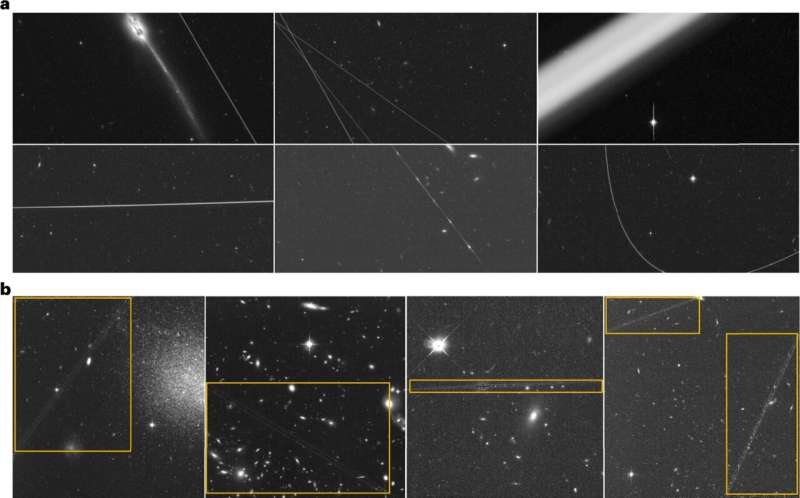
An international team of space scientists is drawing attention to the growing problem of satellite trails marring images taken by space-based telescopes such as Hubble. In their study, published in the journal Nature Astronomy, the group used data from more than 11,000 citizen scientists to assess the degree of the problem and to make predictions about the future.
For many years, scientists working at ground-based observatories have been growing increasingly concerned about the problem of man-made satellites muddying the view of objects out in space. As more satellites have been deployed, and as such telescopes grow more sophisticated and sensitive, concerns have only grown. In more recent years, scientists studying data from space-based telescopes have become more concerned as well, especially in light of plans to send mega-constellations of satellites into orbit.
In this new effort, the researchers focused their work exclusively on images provided by the Hubble Space Telescope. Its orbit is closer to Earth than the satellites in low orbit. Thus, such satellites can sometimes pass between Hubble and its targets. The result is pinpoints of light or trails from satellites across the images, generally making them useless.
To better understand the magnitude of the problem, the researchers recruited more than 11,000 citizen scientists who are participants in the Hubble Asteroid Hunter project. Participants looked at batches of pictures taken by Hubble over the years 2001 to 2021 and flagged those with satellite streaks. They used a machine-learning algorithm to analyze the results and make predictions regarding the total likely number of Hubble exposures.
They found that approximately 2.7% of Hubble images likely have satellite streaks. They also noted that the chances of streaks appearing in any given image increased over the years 2009 to 2020 from 3.7 to 5.9%.
The researchers note that major players in the satellite delivery business, such as Starlink and One Web, have announced plans to send thousands more satellites into orbit, which will greatly increase the number of marred images. They suggest the solution to the problem is to send space telescopes farther into space, as was done with the James Webb Space Telescope.
More information:
Sandor Kruk et al, The impact of satellite trails on Hubble Space Telescope observations, Nature Astronomy (2023). DOI: 10.1038/s41550-023-01903-3
Journal information:
Nature Astronomy
© 2023 Science X Network
Problem of satellite trails marring Hubble images is growing worse (2023, March 6)
retrieved 7 March 2023
from https://phys.org/news/2023-03-problem-satellite-trails-marring-hubble.html
part may be reproduced without the written permission. The content is provided for information purposes only.